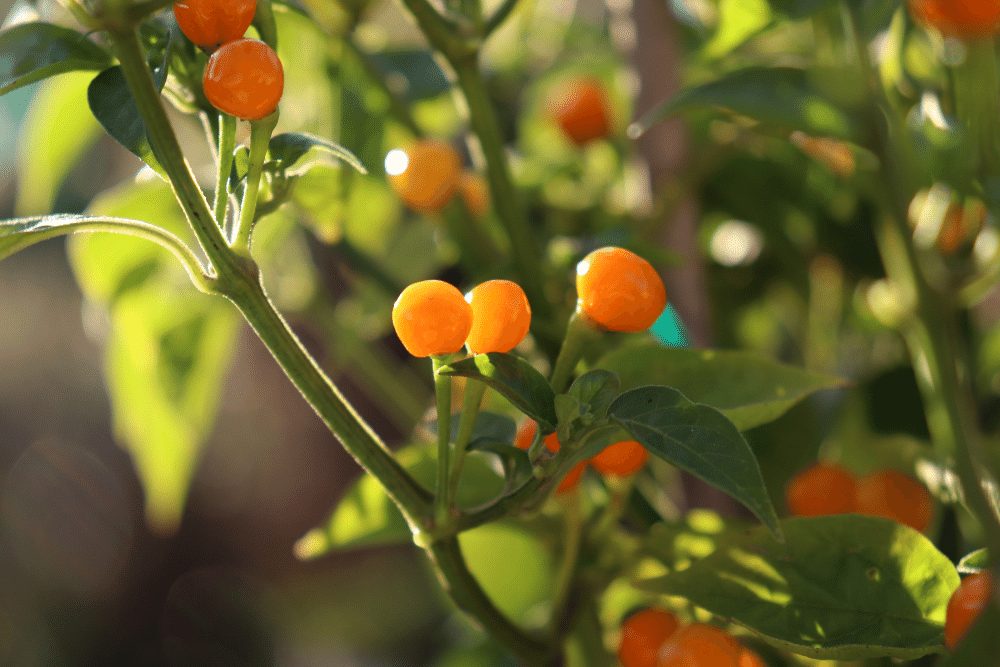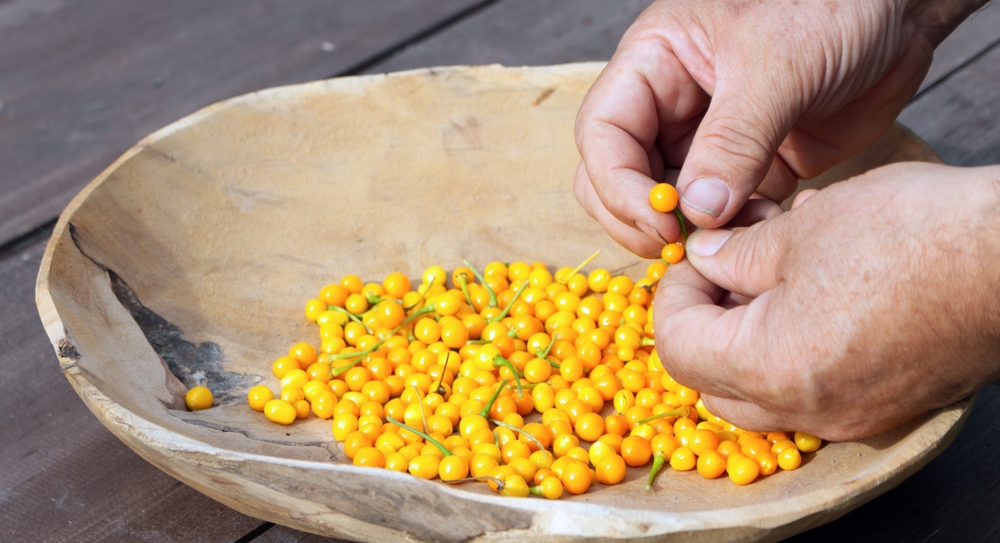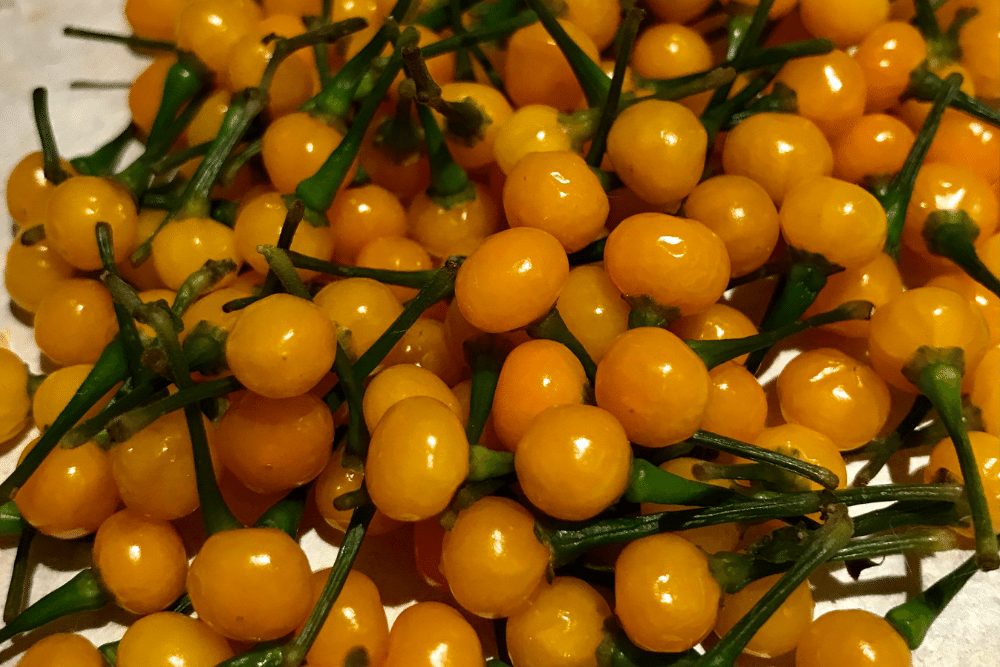Aji charapitas are small, round yellowish-orange chili peppers from Peru, considered the mother of all chilis. These hot peppers have a similar heat level to cayenne peppers, and they occupy a critical corner in the culinary world and the history of chili peppers.
What Are aji charapita Chili Peppers?
Aji charapita chili peppers are tiny hot peppers, only reaching roughly the size of a pea at maturity. They’re native to Peruvian jungles, an unusual climate for the pepper plants most people are used to.
Many don’t know that Peru and Bolivia’s warm, wet climates are widely considered the birthplace of Capsicum chinense, the species of pepper that includes aji charapita and well-known favorites such as the habanero and ghost peppers.
This small pepper grows wild in Peru and is a mainstay spice in many Peruvian households. These peppers have been cultivated and used in Peruvian cooking throughout history. There’s evidence of aji charapita being used dating as far back as 4,000 years ago, thus earning it the designation of “mother of all chilis.”

The bushy plants that give rise to these chilis can produce hundreds of tepin-like peppers from summer through fall. Although they seem to grow in abundance, their size and the fact they’re challenging to find outside of South America means they come with a hefty price tag when purchased in other areas of the world. This scarcity has given rise to the claim that they’re the most expensive peppers in the world.
What Do aji charapita Peppers Taste Like?
Aji charapita peppers have a distinct, almost tropical fruitiness that adds a unique flavor to the dishes in which it’s used. The sweetness and fruitiness have been compared to the habanero, but with greater intensity.
However, this isn’t to say that aji charapita is a sweet pepper. It packs a deceptive punch when it comes to the heat level. At first bite of a dish or salsa made with aji charapita, you’ll notice the tropical nature of the flavor, but within a few seconds, the heat will build, creating a burn that can be overwhelming for some.
How Hot Are aji charapitas?
Aji charapitas aren’t the hottest peppers but are firmly in the hot pepper category. They measure between 30,000-50,000 Scoville heat units on the Scoville scale. This makes them comparable to the Cayenne pepper in heat profile.
The following list can provide perspective on where the aji charapita places when it comes to some of the most popular pepper varieties on the market:
- Habanero pepper, 100,000-350,000 SHU
- Cayenne pepper, 30,000-50,000 SHU
- Aji charapita pepper, 30,000-50,000 SHU
- Jalapeno pepper, 2,500-8,000 SHU
Are aji charapitas The Most Expensive Pepper?
Because of its rarity outside of South America, the aji charapita has earned a reputation as the most expensive pepper on the market. This is an erroneous claim, however.
This tiny pepper grows in abundance in Peru and can be grown outside of Peru and in home gardens if the conditions are right. While hard to find in a neighborhood grocer, there’s no shortage of aji charapitas if you know where to look.
The reputation of prices as high as $25,000 per kilo or roughly $11,000 per pound came from the fact that their small size means cultivating, harvesting, and refining into a marketable spice can be labor intensive. It takes up to 20,000 fresh peppers to make approximately 2 pounds of dried peppers. Grinding and processing into a powder can take even more.

So, making this wild Peruvian chili pepper available for commercial use is a more expensive process than for many other peppers. But you can find Aji charapita seeds and products at much more reasonable prices.
aji charapitas Vs. Chiltepins
Aji charapitas and chiltepins have a great deal in common but a few clear distinctions.
Both are wild chilis, small and berry-like in size, with a fruity flavor. Because of their history in the diets of ancient people, they are both referred to as the mother of all chilis.
There are, however, some significant differences.
- Aji charapitas are difficult to find outside of South America.
- Chiltepins are grown in North America.
- Aji charapitas register between 30,000-50,000 SHU
- Chiletepins register between 50,000-100,000 SHU—much hotter.
How Are aji charapita Best Used?
Because it’s common in Peru, aji charapitas are a common ingredient in Peruvian cuisine.
They’re traditionally used in salsas and hot sauces but can also be added to salads and other side dishes. Aji De Concona is a traditional jungle dish accompanying many meals, which combines concona fruit (pulpy fruit similar to a tomato), aji charapita, lime, and cilantro.
Other uses for aji charapita include:
- Creating a spicy chimichurri sauce to add to flank steak
- Charapita pepper jelly
- Aji De Gallina (a Peruvian chicken dish served with pita bread)
Aji charapita peppers can be used in almost any recipe that calls for habaneros or other spicy peppers with a similar fruity flavor profile.
Where To Buy aji charapita Chili Peppers
Outside of Peru, it can be very difficult to find fresh aji charapita peppers. Specialty grocers that carry international foods or Peruvian markets may occasionally carry them, but mainstream commercial grocery stores aren’t likely to.
What can be found, however, are products made from aji charapita peppers, such as ground chili powders and pastes. These aji charapita peppers are becoming more common on grocery shelves. Online retailers like Amazon also carry aji charapita products.
Can You Grow aji charapita Peppers?
Because it’s hard to find fresh aji charapita peppers for purchase, you’ll likely have better luck growing them your own.
Charapitas are relatively easy to grow under the right conditions. They’re often grown as a house plant in Peru, and the peppers are picked as needed.
Aji charapita pepper seeds can be easily found and ordered on many sites, including Amazon. Etsy advertises specialty growers with live aji charapita plants available as well.
Seed prices range quite a bit. They can be anywhere from $4 for 10 seeds to $6 for 50 seeds. When purchasing, it’s essential to consider the reputation and reviews of the seller to ensure quality seeds.
If growing from seed, expect them to sprout in 7-10 days. The seedlings need to be kept warm, and even as full-grown plants, aji charapita is not frost-tolerant.
Conditions for proper growth should be:
- 8-10 hours of sun
- Temperatures between 70-95 degrees Fahrenheit
- If plants are in direct afternoon sun and temperatures exceed 100 degrees Fahrenheit, consider shading them in some way to avoid sunburn.
- Moist but not wet well-draining soil.
- Approximately 18 inches for spreading. Remember, these pepper plants grow as a bush.
Substitutes For aji charapitas
If you cannot find aji charapitas, several suitable substitutes are available. Keep in mind, however, that suitable doesn’t mean identical.
- Chiltepin peppers. This North American cousin will have a similar flavor profile but a much hotter Scoville rating.
- Aji amarillo peppers. Another native Peruvian chili. The slightly sweet, almost raisin-like flavor and heat may be the most similar to the aji charapita. Unfortunately, it’s also similar in its rarity outside of Peru.
- Habanero peppers. Not as fruity and much hotter.
- Serrano peppers. Not as hot and has a slightly different flavor, but it can work in a pinch.

